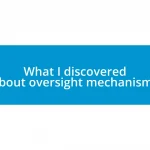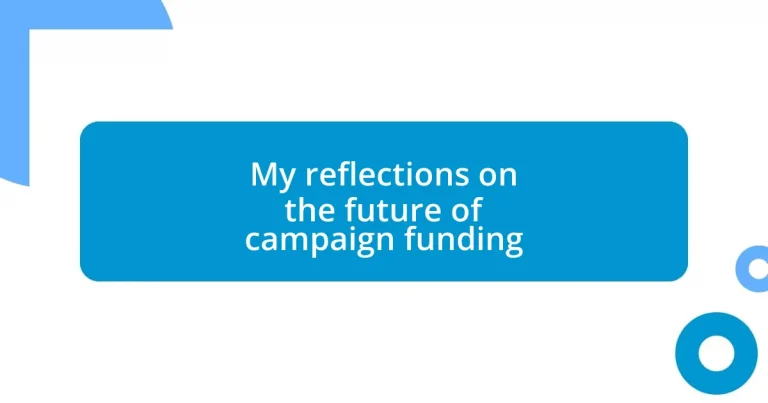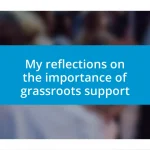Key takeaways:
- Digital platforms are revolutionizing campaign fundraising, enhancing engagement with small donors and grassroots support.
- Public financing options can level the playing field, encouraging diverse candidates and reducing reliance on wealthy backers.
- A balance between transparency and regulation is essential to enhance accountability in campaign funding.
- Future campaign finance may see advancements like blockchain for secure donations and a rise in decentralized funding models through crowdfunding.
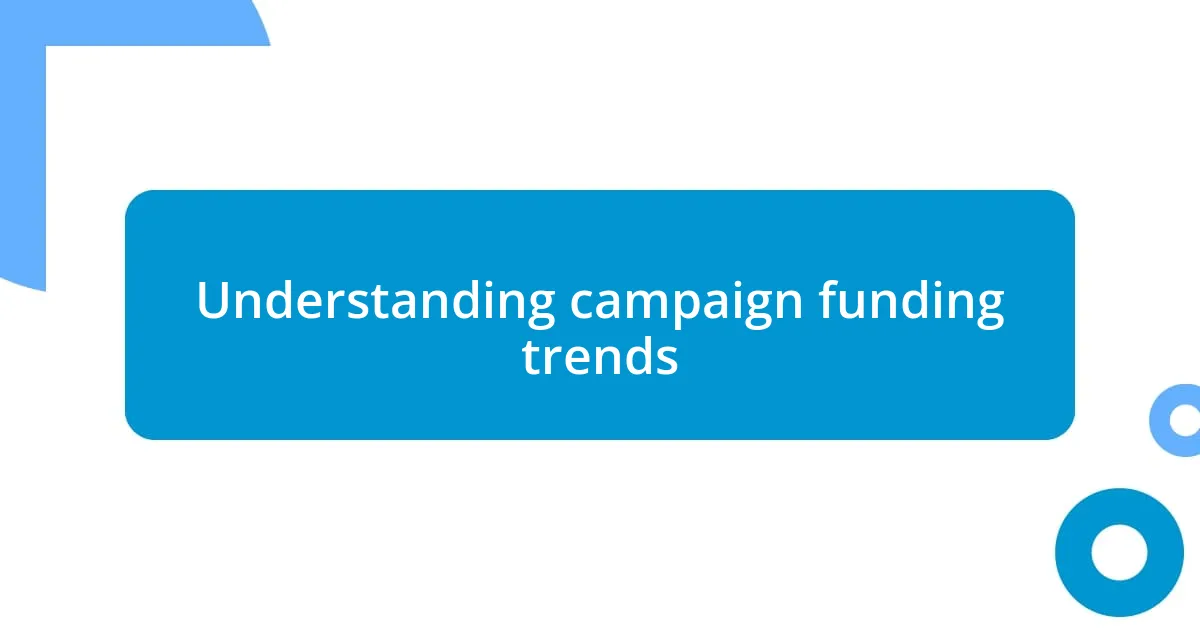
Understanding campaign funding trends
Campaign funding trends are evolving rapidly, and as someone who’s followed this landscape closely, I find it fascinating to watch how digital platforms have transformed fundraising. For instance, I remember the first time I witnessed a grassroots campaign raise thousands through social media in just one day. It made me wonder, how could a single tweet ignite such an overwhelming response?
Moreover, one trend that sticks out to me is the growing influence of small donors. I’ve seen firsthand campaigns that rely less on large donors and more on the collective power of individuals who can contribute even just ten dollars. This shift not only diversifies the funding base but also fosters a sense of community among supporters. Isn’t it intriguing how this pattern might reshape the priorities of future candidates?
In my experience, data also plays a crucial role in understanding these trends. Campaigns are increasingly using analytics to target potential donors more effectively. I reflect on how different it was years ago, when campaigns relied heavily on traditional methods. Now, with the rise of sophisticated tools, candidates can directly engage with their audiences in ways that were once unimaginable. How do you think this level of engagement will impact voter attitudes in the long run?
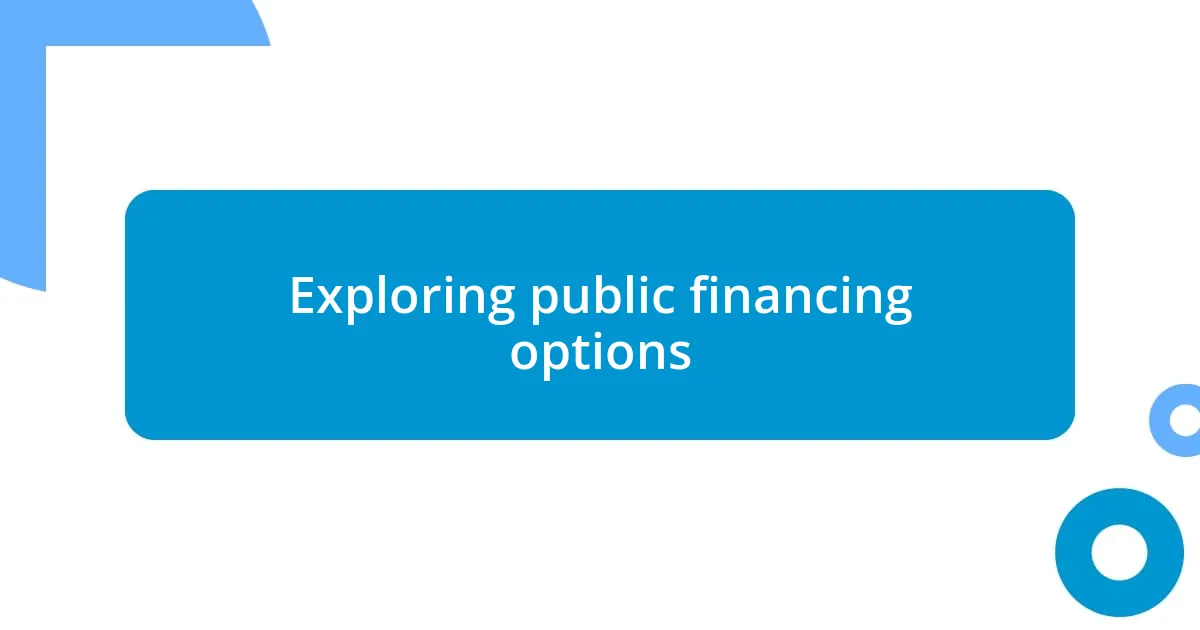
Exploring public financing options
Exploring public financing options can be a game changer in the political landscape. I’ve often pondered the potential of systems that rely on taxpayer contributions to support candidates, particularly for those from underrepresented groups. It brings to mind a time when I volunteered for a campaign that struggled to secure traditional funding, and the sheer impact that a small public financing boost had on our outreach efforts. Suddenly, we could afford to reach more voters and share our ideas without the constant pressure of big donors looming over us.
By implementing public financing, candidates can focus on their message rather than fundraising. I remember attending a local meeting where community members expressed their frustrations about feeling disconnected from candidates who prioritize a handful of wealthy backers. When public financing options are in place, the playing field might become more level, encouraging a broader spectrum of voices in the political conversation.
However, there are challenges to consider. Public financing could require careful regulations to ensure transparency and prevent misuse of funds. Reflecting on my experience, I’ve seen how public trust can dwindle with the slightest hint of corruption. So, I ask myself, how can future systems be structured to ensure accountability while still empowering candidates?
| Public Financing Option | Description |
|---|---|
| Matching Funds | Public funds match small donations at a specific ratio, incentivizing grassroots support. |
| Clean Elections | Candidates receive a set amount of public funding in exchange for agreeing to limit private contributions. |
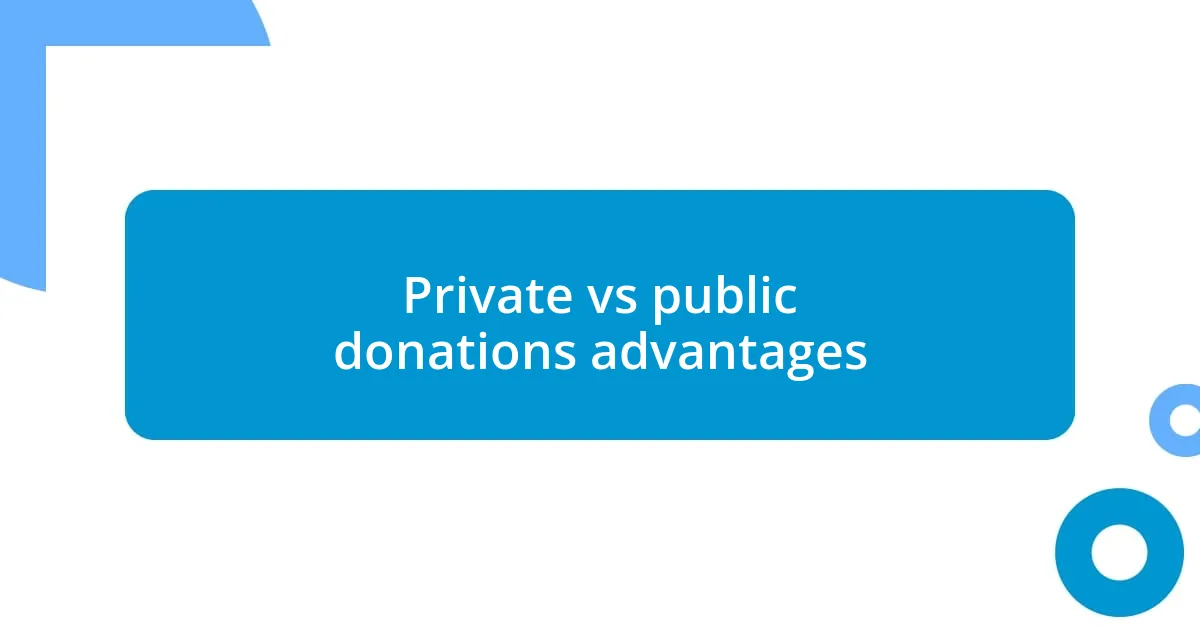
Private vs public donations advantages
Private donations can offer significant advantages, especially when it comes to flexibility and speed. I think back to a candidate I supported who was able to quickly mobilize resources for unexpected expenses during the campaign. When large funds are at stake, decisions can be made swiftly, allowing for rapid responses to changing circumstances—something that traditional public funding often struggles to achieve. However, this rapid access can also lead to a treasury that may favor the agendas of a few wealthy individuals over the voices of many.
On the other hand, public donations foster a greater sense of community involvement. I’ve participated in volunteer drives where small, public contributions united people around a common goal, transforming casual supporters into dedicated advocates. It’s a beautiful sight to see everyone come together, believing they’re part of something bigger. Here’s a quick rundown of the advantages:
-
Private Donations:
- Fast access to funds for immediate needs
- Potential for larger sums that can amplify a campaign’s reach
- Flexibility in campaign strategy and spending
-
Public Donations:
- Encourages widespread participation and grassroots involvement
- Reduces the influence of wealthy individuals on the political narrative
- Strengthens accountability and encourages candidates to focus on voter interests, not donor interests
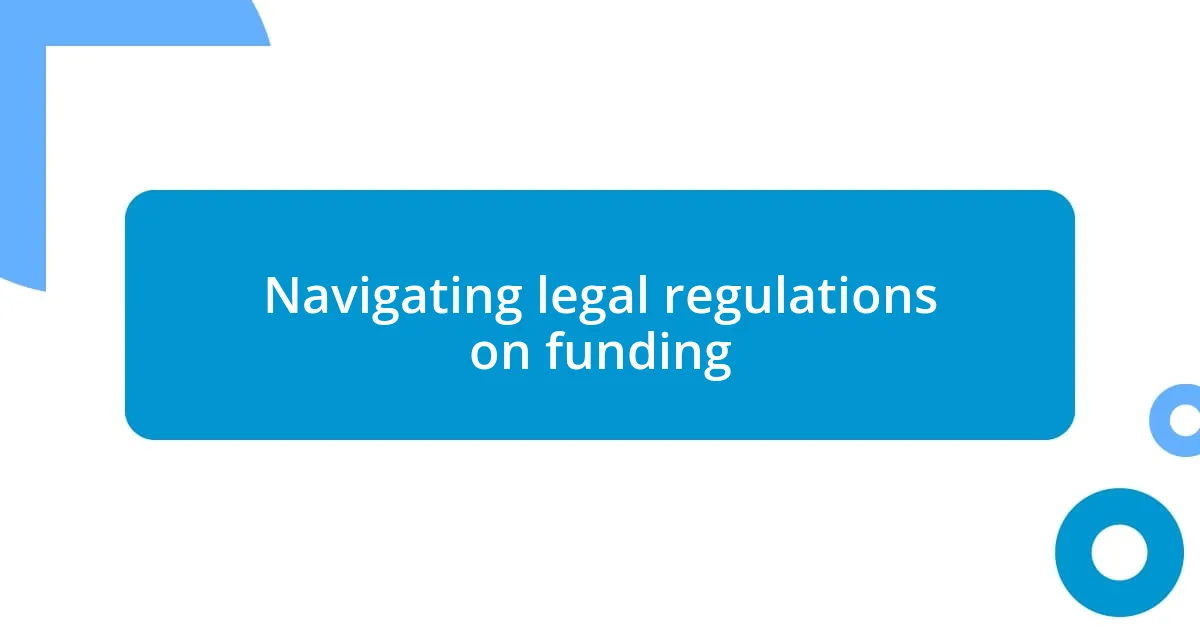
Navigating legal regulations on funding
Navigating the legal regulations surrounding campaign funding can feel like traversing a complex maze. I recall attending a workshop that focused on compliance laws—what a whirlwind of rules! It reminded me that even the best intentions can become tangled in red tape, making it difficult for candidates to understand what they can or cannot do. How do we ensure that newcomers to the political arena aren’t overwhelmed by these complexities?
Transparency is crucial, yet I’ve seen how complicated regulations can inadvertently obscure the lines of accountability. There was a time when I worked alongside a candidate whose funding sources were under greater scrutiny due to recent legislation. The pressure was palpable; we needed to demonstrate every dollar’s legitimacy, or risk losing voter trust. I often wonder, how can we streamline these regulations to protect integrity while also encouraging diverse candidate participation?
Another challenge comes with the enforcement of these regulations. I remember a campaign where we faced daunting penalties for minor infractions, creating a climate of fear around fundraising. It made me think: shouldn’t the focus be on educating candidates about the rules rather than punishing them? As we look to the future, I believe promoting understanding over enforcement could pave the way for more ethical fundraising practices. After all, an informed candidate is a confident candidate.
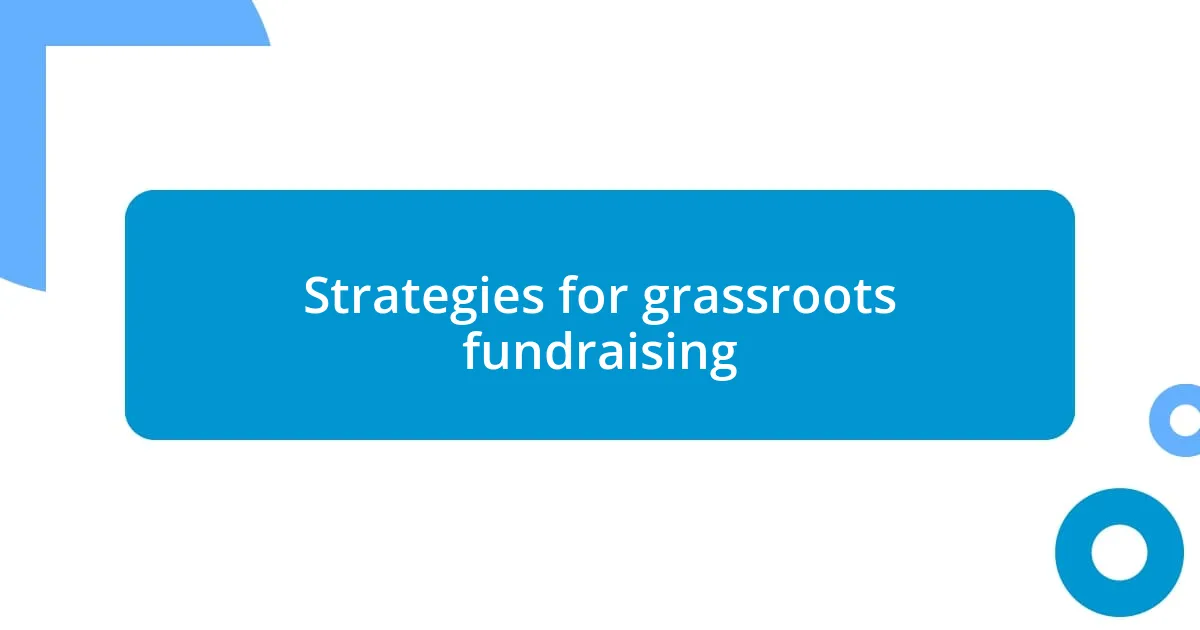
Strategies for grassroots fundraising
Grassroots fundraising thrives on connection and community. I remember organizing a small local event where neighbors came together to share food and stories while raising funds. Watching the joy in everyone’s faces reminded me that when people feel personally invested, they not only donate financially but also become long-term advocates for the cause. It’s all about creating a space where individuals understand their contributions matter.
Leveraging social media can also be a game-changer for grassroots campaigns. I’ve seen campaigns go viral because a passionate supporter posted a heartfelt message about the candidate. Engaging supporters through platforms like Instagram or Twitter allows for rapid sharing of messages and easy avenues for small donations. It’s both exciting and empowering to think about how a single post can rally hundreds of people to contribute.
Finally, I can’t stress enough the impact of transparency in fundraising efforts. During a campaign I was involved in, we shared regular updates on how donations were being used. It built trust and encouraged others to give, knowing there was a clear purpose behind every dollar. How can we ensure that every campaign embraces this openness? For me, it stems from a genuine commitment to the community—when donors see the real-world impact of their contributions, they feel more connected to the mission and are likely to give again.
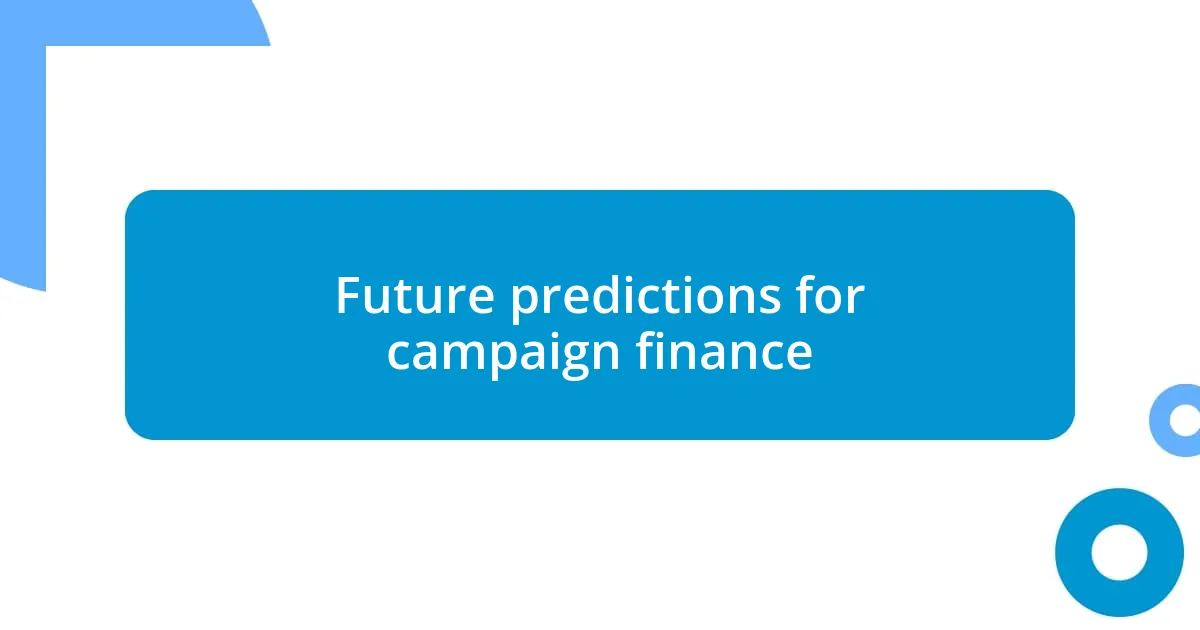
Future predictions for campaign finance
I foresee significant changes in campaign finance as technology continues to evolve. I was recently at a conference where a speaker discussed the increased use of blockchain for secure donations. Imagine a future where every transaction is transparent and traceable, eliminating the murky waters of anonymous donations. Could this level of accountability inspire more trust among voters?
As we move forward, I anticipate a rise in decentralized funding models. For instance, I experimented with a crowdfunding platform during a local campaign, and it was invigorating to see everyday citizens become investors in our vision. This shift could democratize campaign finance, allowing smaller voices to influence politics significantly. Will we move towards a system where every small donation can collectively challenge the traditional big-money backers?
Moreover, I think we may witness stronger grassroots movements powered by digital platforms. I remember feeling the exhilaration of a last-minute social media push that doubled our fundraising in just a few days. As political engagement grows online, will we see a new wave of candidates emerging from communities rather than party machinery? The excitement around this possibility keeps me hopeful for a future where funding is more accessible and representative of the electorate’s diverse interests.






